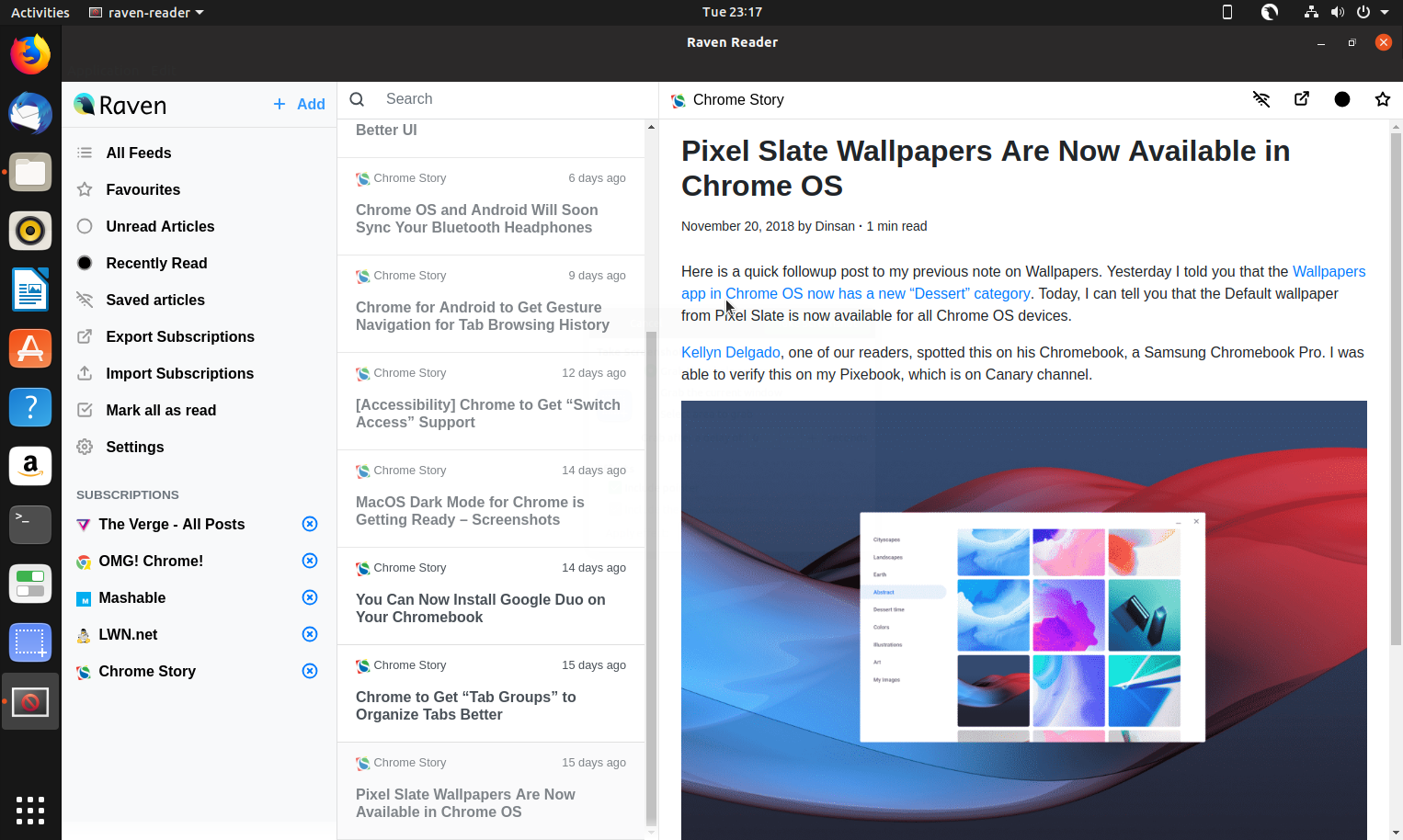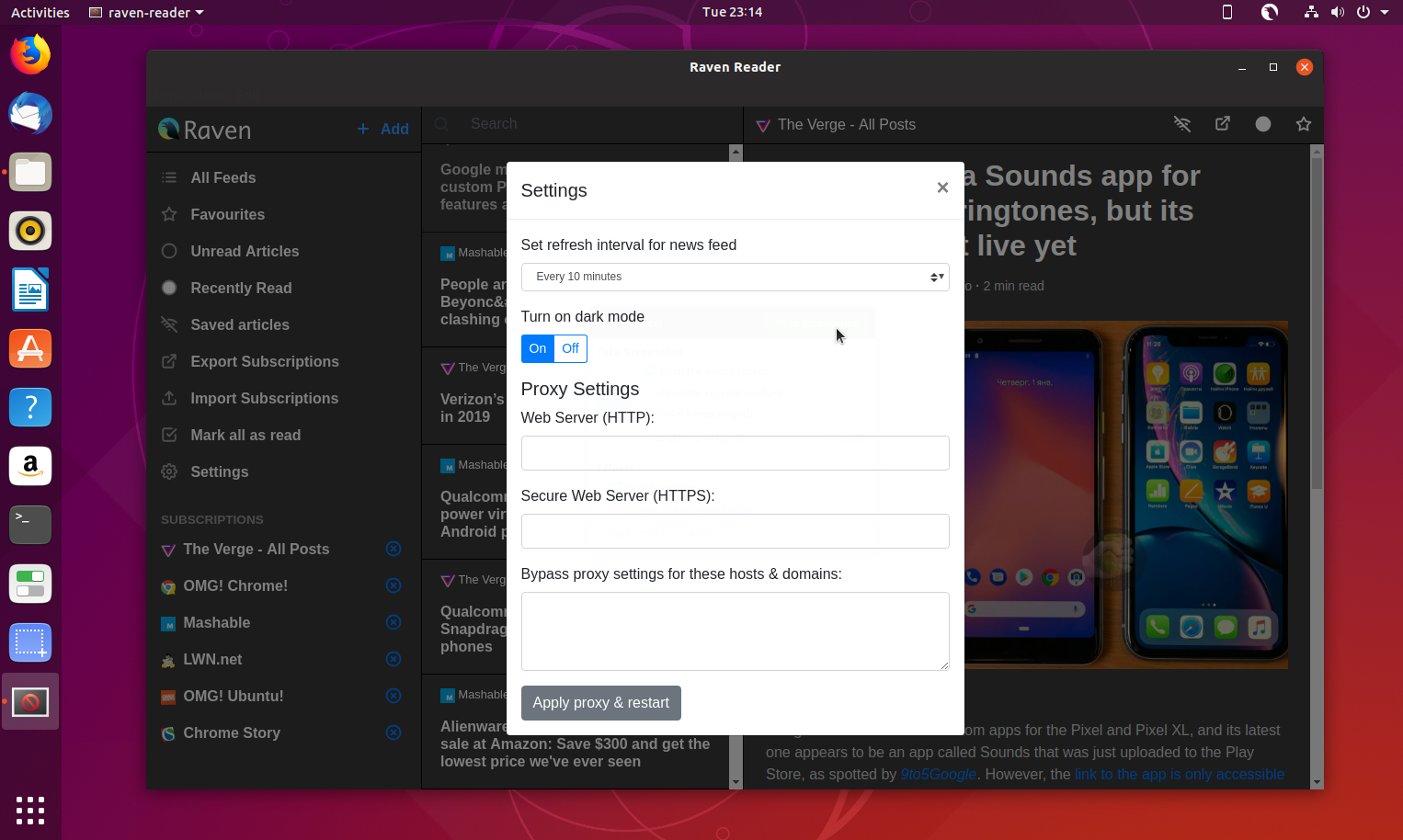Raven is a new open source RSS reader app for Windows, macOS and Linux that I’ve been eager to try out.
This week I finally found some time to dig into this deliciously well designed desktop RSS feed reader. In this post I’ll provide you with an overview of what Raven can do, what it can’t do, and how I think it could be even better than (spoiler alert) it already is.
But before we go any further you may want to made aware that this open-source, cross-platform RSS reader is built using Electron.
Not fussed? Me, either, but that will be a deal-breaker for some.
Wait, what’s RSS?
RSS (Really Simple Syndication) is a standardised web format for delivering updated web content to whoever wants it via RSS feeds.
Though out of fashion with mainstream users, RSS is far from out of use. The format still has fans and I’m proudly among them
But the popularity of RSS for news distribution is in decline.
Few websites or blogs tend to the format as a primary method of delivering content updates to readers nowadays. Outlets instead opt to rack up follows, likes and fans on social media — which makes sense: RSS is passive, while social media is interactive, engaging, and immediate.
Though out of fashion with mainstream users RSS is far from being out of use. The format still has its fans — I’m proudly among them — who often use dedicated apps to stay on top of the latest posts and updates from their favourite blogs, sites and projects.
On the desktop that takes the form of an RSS reader, which consolidates all the latest content, headlines and news from various blogs, sites, and services into one, manageable place — a place designed for reading.
And Raven is one such app.
Raven RSS Reader
One thing Raven has right from the off is its look: it’s clean, with ample spacing, and isn’t crowded up by buttons and toolbars.
Raven uses a three-pane layout:
On the left is a sidebar listing RSS feed sources and a slate of filter options, including “All Feeds”, “Recently Read” and “Unread only”.
In the middle is the “article list” showing article headline, site name, publish date and an easy-to-spot site favicon.
On the right is the “content” area where a plain-text version of each article is presented.
The size of the first two columns isn’t adjustable but the width of the reading space can be made wider or more compact depending on your needs.
Adding feeds is easy: click the bold blue add button, tap in a site URL and Raven will auto-detect any available feeds. Helpfully, when adding feeds you have the option to change the site name/label too, handy if you only subscribe to specific sections of a website.
Alas, you can’t rename feeds once added, or adjust their order once added.
It’s a Local RSS Reader
All feeds you add to Raven are stored and managed locally. There’s no cloud-service layer in the middle to keep things in sync between devices or platforms.
You can import (and export) a feed list easily, though. If you currently use a different app or service (i.e. Feedly) it isn’t much effort to get a dump of all your sites in a text file and get it loaded into Raven.
Raven’s logical layout makes it easy to quickly sort through feeds based on site, search term or read/unread status. It uses “bold” font in headlines to designate unread items and a duller, greyed-out version for read items.
You can also bookmark articles as ‘favourites’ to find them at a later date, or save articles for offline reading.
Missing Features
It’s still early days for Raven Reader, meaning there are some drawbacks, gaps and caveats.
The biggest? There’s no integration with cloud-based RSS services like Feedly. This makes using the app across devices a hassle as the feeds you read on one OS won’t be marked as read on another — and you’ve no options on mobile.
There’s no integration with “read it later” tools like Pocket, and you won’t find quick links to share an article on social media, email it to someone, or copy the URL to your clipboard.
Although there is an “open in browser” option there’s no built-in web view (ironic given this is made with Electron). It’s not a major issue, but would be handy for times you want to view articles on site as they are supposed to look (important given some media can only be viewed on a web page) without Firefox lunging into view.
Search is wonky, too. Raven orders search results by date (good) but grouped by feed (odd). You’d expect feeds to be ordered by date solely, with the most recent unread item being first. As it is, you end with a post from 6 months ago from site A listed above posts from today from site B, C and D.
The lack of counts in the sidebar for read and unread items also irks me. It makes it very hard to know how much “unread” news is actually there. While you can use the ‘Unread only’ filter to see them, a quantifiable label would up the usability a lot.
Finally, and most importantly, there are no text configuration options.
A desktop RSS reader has to offer a great reading experience. It’s the very reason people use them: to read. While Raven is pleasant enough in this regard I do feel that some font settings, a choice of background colour, and some spacing options would really ice the cake.
Is Raven Reader the best RSS reader for Linux?
Liferea, FeedReader and RSSOwl are 3 alternative open-source RSS feed reader apps readily available on Linux (and in some cases macOS and Windows too) and most often recommended when people are looking for an RSS reader for Linux.
Last year we checked out the GTK+ Feedreader and came away impressed. It has a decent set of features, nice desktop integration, and hooks in to popular feed sync services (including Feedly).
We also looked at Liferea with fresh eyes to ask if, as many claim, it is still the best RSS reader for Linux desktops (spoiler: ish).
But while there are plenty of RSS readers for Linux, Raven makes a big impression with its beautifully simple layout, OMPL feed support, and optional dark mode.
I won’t be as bold as to call Raven the best RSS reader for Linux yet, but it’s certainly the most promising, Electron or not.
P.S. Raven’s app menu doesn’t show up under some GTK themes so to quit the app you need to focus it and press ‘Q’.


